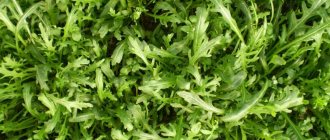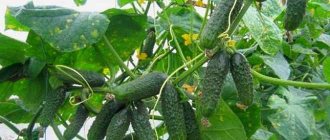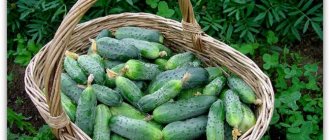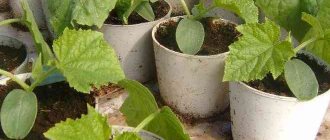Description and beneficial properties of Arugula
Arugula is a close relative of cabbage and mustard. This is a plant with a lodging aerial part. When properly grown, its height reaches 40-65 cm. In our country, Arugula is cultivated as a leaf-type salad crop. It has many different names, the most popular being Inda, Rocket Salad or Walking Salad.
The leaves of the plant contain large amounts of vitamin B and C, as well as magnesium, zinc, and iron. These substances have a positive effect on the immune system and reduce the number of dangerous bacteria throughout the body.
Arugula is an effective remedy for various stomach diseases. In addition, this plant has a positive effect on hair growth, strengthening nails and normalizing weight.
What do you eat arugula with?
The seasoning leaves are used in salads, and a tasty and healthy oil is made from the seeds.
Like all greens, arugula does not tolerate heat treatment. You can only allow blanching for no more than 2 minutes.
Traditionally, these greens are combined with Mediterranean products: shrimp, pasta, cheese. Cucumbers and tomatoes, which are familiar to Russians, will sparkle with new colors in combination with arugula. It's also good with nuts. Oil, especially olive oil, enhances its taste.
In addition to salads, arugula can be added to pizza or any first and second courses. The main thing is to do this after cooking.
Not everyone likes the way this salad smells. To eliminate the smell, experienced housewives advise rinsing the greens under running cold water and sprinkling with lemon juice.
The greens are not cut, but torn by hand. It is very important to use only freshly picked herbs and eat food soon after preparation.
The most common varieties of arugula
Arugula Wonder
The bush grows up to 20 cm and has a significant number of leaves. They are distinguished by a smooth surface and lack of roughness. The average weight of one bush reaches 18-20 g. During flowering, the inflorescences acquire a beautiful creamy shade and are covered with brown veins.
The variety develops well in waterlogged soils and is capable of producing a significant amount of greenery from mid-summer until the first autumn frosts.
Cupid's arrows
It belongs to the mid-season varieties and can be used for food within 25-28 days after germination. The height of the plant is 20-22 cm. A feature of the variety is the possibility of late bolting and a high marketable appearance. The leaves have a wavy structure and are green in color. Plants are distinguished by leaves raised above the ground, which form a uniform rosette. The flowers are uniformly blooming and yellow in color.
With proper cultivation, the yield per 1 m2 is 2.7-3 kg per season. fresh greens.
Variety Rocket
An early ripening variety with dark green wavy leaves with fine teeth on the sides. The leaves have a persistent mustard aroma. After the first cutting of the leaves, new shoots quickly appear with a bitter-sharp taste. The leaves of the Arugula Rocket variety contain a large amount of vitamin C. The variety can be successfully grown both in a greenhouse and in closed ground conditions.
The grown crop is intended for preparing appetizers and complex main courses.
Arugula Solitaire
The variety was created in 2007 and since then has been popular among vegetable growers in our country. Plants are able to withstand even very frosty winters and with the arrival of spring they begin to grow rapidly. Before harvesting the first harvest, 28-30 days pass from the moment of emergence. The leaf blade has a neat appearance with cuts on the edges. At the final stage of its development, the variety blooms with yellow inflorescences. The plants have a fairly strong and persistent aroma with mustard and nutty undertones.
During the growing process, you can use the conveyor method.
Indau Victoria
Arugula of the Victoria variety can be cut for greens within three weeks after emergence. A universal variety with a rosette height of 16-25 cm. The leaves are slightly raised above the ground and completely cover the bush. The color of the leaves is green with light veins. Plants have a strong aroma and contain a large supply of useful minerals and vitamins.
The grown crop goes perfectly with meat and other vegetables.
What is arugula, subtleties of growing, care
What are yellow-green vegetables
dill, Chinese, Chinese and Japanese cabbage, mustard, watercress
Despite the fact that the listed plants belong to different families, they have much in common. They
Well, arugula is gradually occupying higher positions in this list thanks to its exquisite unusual taste and
Types of arugula, varieties for growing
several varieties: Gourmet, Curiosity, Corsica, Rococo, Little Mermaid, Sicily
The most tried and tested is Poker.
Poker
The fruit is an indehiscent pod containing about 30 seeds that remain viable for 4 years. Arugula develops in 75-90 days.
The benefits of arugula, wild arugula, breeding varieties
From the rank of restaurant greens
But there is also wild arugula (two-row thin-leaved), which is called wild rocket. She too
varieties Roket, Taganskaya Semko, Euphoria. The most fragrant Solitaire
The taste of Solitaire is mustard-nutty, sharper than that of Poker. And unlike the latter, this is a biennial. Its roots overwinter, produce new leaves in the spring, then open pods, as in the first year of life. Then the plant dies. Solitaire contains a lot of mustard oil, nitrogen and sulfur. This plant is tasty for humans, but harmful to insects.
Features of growing arugula
You can grow both of these types of arugula easily, literally effortlessly.
Arugula has small seeds, first they are sown in a glass to a depth of 0.5-1 cm. Mass shoots
Arugula prefers light soils with a slightly acidic reaction, so acidic soils must be limed. If you bring soil from your own plot for a winter vegetable garden on the window, the one taken from the garden bed is suitable for arugula.
Arugula blooms in long days and elevated temperatures. Withstands frosts down to minus 5-7°C.
Rucola does not like shade, although it can certainly tolerate it. If you feed it with nitrogen fertilizers in insufficient lighting, nitrates will accumulate and the chemical composition will change.
the taste will disappear
If the plants do not have enough moisture, the leaves become coarse and bitter, so regular watering is necessary. The sooner you start picking off the leaves, the faster the bush will grow. Growing up - when
It usually takes 20-35 days from full germination to the first cutting. The weight of a rosette of leaves can be 20-60 g depending on conditions. Greens can be stored in the refrigerator for about 7 days; before that, they must be sprinkled with water.
What to cook from arugula
Arugula greens
To excite passion, Italian chefs recommend this ancient potion: you need to crush 100 g of arugula and, adding 10 g of black pepper and honey, mix everything. Take a teaspoon every morning.
100 g of arugula contains: 15 mg of ascorbic acid, 1.8 mg of vitamin A, 48 mg of vitamin B9. The plant is rich
Arugula salad becomes much tastier if you put it in the refrigerator for 5-6 hours. Need to
Thanks to its biologically active substances, arugula has a beneficial effect on digestion and has
If you eat it regularly, immunity and hemoglobin increase, metabolism is normalized, and blood sugar levels decrease. It is believed that it is useful to eat it for the prevention of cancer.
Anatoly Tsiunel
bestgardener.ru
Arugula growing options
This plant can be grown in various conditions. Moreover, each cultivation option has its own cultivation technology, which must be adhered to.
In the greenhouse
In the greenhouse, you can maintain optimal temperature conditions (at least + 16 degrees) and effectively disinfect the soil. It is very important in the growing process - artificial lighting, timely feeding and watering. Growing Arugula in a greenhouse allows you to get an earlier harvest of greens.
On the beds
This method is the least expensive, but its use gives a significantly smaller yield than when growing Arugula in a greenhouse. When growing outdoors, it is very important to know when to sow the seeds. You can sow Arugula from mid-May until the end of August. The interval between sowings should be 9-10 days. Semi-shaded areas are best suited for growing this crop.
Arugula plants cannot withstand direct sunlight.
Otherwise, the growing technology is quite standard with the use of timely watering, loosening and fertilizing. In some years you will have to deal with pests and fungal diseases.
On the windowsill
If you don’t have a plot of land, you can grow Arugula at home on a windowsill. It is recommended to plant in a container measuring 20 x 20 x 20 cm.
An important aspect is the optimal level of illumination and timely watering. In addition, it is necessary to use a fertile soil mixture with an optimal acidity parameter.
Arugula: one name, two plants. How to distinguish
If you already have experience growing arugula, you may have noticed that plants grown from seeds with the same name may not be the same in appearance and taste, or on the packaging next to the name of the same variety there may be different plant names.
Confusion may also arise with the appearance in the picture. Everything is explained simply: under the name “arugula” two cultures are hidden.
The commercial name, which came to us from Italy, is today actively used in trade (in stores, on packages, in catalogs), among vegetable growers, and in cooking. In special botanical literature, another name is used - indau sativum, or eruca sativum (from the name in Latin). This plant belongs to the Indau genus of the Brassica family and is a cultivated arugula.
The indau plant is an annual, prostrate plant, reaching a height of 30-60 cm, characterized by wide lyre-shaped leaves with a serrated edge.
The inflorescence is a sparse long raceme. The flowers are light, almost white with purple veins, sometimes yellowish or cream. Small, light brown arugula seeds, similar to mustard seeds, are arranged in two rows in a pod 2-3 cm long. Arugula greens have a spicy-pungent taste.
Thin-leaved two-row is a perennial lodging plant 40-70 cm high, belonging to the genus Two-row of the Brassica family. This plant, which is not very common in our country, is grown abroad as a leafy salad crop with the commercial name “wild arugula.” It is distinguished by narrow leaves with greater dissection. The flowers are yellow, eventually turning orange. The seeds are very small, similar to poppy seeds, placed in two rows in pods 2.5-4 cm long. The greens taste sharper than those of indau.
Planting Arugula
Planting must be done in a certain sequence and in compliance with certain technological features.
Seed preparation
This work should begin several weeks before sowing time. First of all, the gardening store selects varieties of arugula that are suitable for growing in your region. Next, a few days before sowing, the seeds are carefully sorted and large and completely healthy specimens are selected for sowing. Selected seeds are disinfected in a weak solution of potassium permanganate or using chemical disinfectants (Vitavax 200 FF).
Soil preparation
If arugula is grown in a greenhouse or in an ordinary garden bed, then after harvesting the predecessor it is necessary to carry out high-quality soil treatment. To do this, the area is dug up or plowed to a depth of 13-15 cm, and subsequently, as the weeds grow, it is necessary to loosen the surface to a depth of 3-5 cm.
To grow arugula at home, you can buy a ready-made soil mixture at a flower shop or prepare the soil yourself. To do this, mix 2 parts of black soil with 1 part of sand and 1 part of rotted manure. The sand must first be calcined. Wherever arugula is grown, the soil substrate must have neutral acidity.
When to plant Arugula
You need to sow Arugula seeds several times in one season, starting from the first ten days of May until the end of August. It is very important that before sowing the seeds, the soil has already warmed up to + 9 + 14 degrees. If the soil temperature is lower, then in the future the process of seed germination and the subsequent development of seedlings will slow down.
Scheme for planting arugula in open ground
Sowing should be carried out in pre-prepared holes with a depth of 2-3 cm. The distance between adjacent rows should be 30-40 cm. The interval between holes in a row should be at least 5 cm. 2-3 seeds should be placed in one hole. In a week, seedlings will appear on the soil surface, which will need to be thinned out, leaving 1-2 young plants in one planting hole.
Arugula is planted in no more than three rows
When to plant and how to care in open ground
Planting on beds can be done more than once per season.
Seeds usually begin to be sown in April-May (depending on the region), and for the final harvest they are sown in mid-August. To grow from seeds, you need to wait for optimal weather conditions: the earth should warm up to +15 degrees, and the average daily temperature should reach at least +5. Some varieties are frost-resistant, but it is better not to subject the plant to such tests.
It is recommended to do the first planting in spring using seedlings from mid-May to mid-June. Two weeks before the intended planting, sow the seeds at home in boxes with soil.
And this is done like this:
- Pour soil into pots or boxes; universal garden soil will do.
- Make furrows no more than 0.5 cm deep and sow the seeds. It is better to use tweezers, since the seed material is very small. If the planting turns out to be thickened, then during transplantation, divide the bushes and plant them as needed.
- Sprinkle the seeds, water with a watering can or spray the soil with a spray bottle.
- Cover the boxes with plastic to help the seeds germinate faster.
In about a week the first leaves will appear.
After another week, the seedlings can be planted in the beds. Do not forget to water the plantings in pots and boxes: the soil must be consistently moist.
Now you need to choose the optimal place for planting arugula, because it will not grow equally well in every area. The garden bed should be located in a place well lit by the sun. Some varieties tolerate shade, but in such conditions there will not be a rich harvest! The plant grows well in areas where tomatoes, potatoes, carrots, legumes and pumpkins were previously planted. Avoid areas where radishes and cabbage grew.
You also need to pay attention to the pH of the soil. In an acidified area, arugula simply will not grow: it prefers neutral or slightly acidic soil
To deoxidize, you can add dolomite flour, lime or ash to the ground. Dig it up.
Planting seedlings:
- Water the seedlings in pots so you will do less damage to the roots. Remove the bushes from the container.
- Prepare holes, the distance between which should be at least 10 cm, and between the rows - 30 cm or more.
- Arugula along with a lump of earth should be placed in holes, dug in, and watered.
- Although the plant is frost-resistant, it is weakened after transplantation. Night frosts can come unexpectedly, so cover the arugula with plastic bottles or film overnight for the first 2-3 days after transplanting. Don't forget to open it in the morning, otherwise the afternoon sun will burn the foliage.
- Sow the seeds
- Prepare the beds, make grooves 5 mm deep.
- Using tweezers, place the seeds along the grooves at a distance of 15 cm from each other. Keep a distance of 35 cm between rows. The values are greater than when planting seedlings, since a small seed will grow into a voluminous bush. As a result, we will meet the 10/30 standards.
- Water the plantings by drip (watering can or spray bottle).
- If thickening occurs during planting, plant the seedlings when 3 true leaves appear.
Caring for the plant is quite simple, but it needs to be given special attention, because without your help the arugula will die or grow weak. Water according to the condition of the soil; it must always be moist.
It is ideal to irrigate by sprinkling in the evening. You need to do this work once every two days, and in the hot summer - every evening
Water according to the condition of the soil; it must always be moist. It is ideal to irrigate by sprinkling in the evening. You need to do this work once every two days, and in the hot summer - every evening.
Since the soil will be consistently moist, it will begin to compress and the roots will not receive the required amount of oxygen. Each time after watering, the soil needs to be loosened between the rows with a wooden stick or small rake. Remove weeds immediately: they take away a lot of nutrients from cultivated plants.
You can feed arugula only with ash. The fact is that the leaves of this plant absorb everything that gets into the soil. This also applies to harmful compounds present in fertilizers of chemical origin.
Caring for Arugula
After germination, a period of caring for young plants begins. The development of plants and the yield of Arugula greatly depend on the correctness and timeliness of care.
How to water
In order for Arugula to form a powerful above-ground part, it is necessary that the soil is constantly moist. In this regard, it is recommended to water at least 3-4 times a week. The optimal watering volume is 20-24 liters. per 1 m2. If hot weather sets in, watering should be carried out daily with a volume of 20 liters. per 1 m2. When Arugula ceases to receive the required amount of moisture, the castings acquire a bitter taste and become unsuitable for consumption.
Despite the increased moisture-loving nature of the plant, there is no need to allow water to stagnate on the soil surface.
How to Harvest Arugula
It is very important to collect Arugula on time. Delay in harvesting leads to the fact that the plant castings turn yellow and acquire a bitter taste. The main sign for the start of harvesting is the length of the leaf, which should be about 10 cm. During the harvesting process, large rosettes are cut off completely. On other bushes, the leaves are partially cut out.
The harvested crop can be eaten fresh or stored in the refrigerator. In the latter option, before storing, wrap the bunches of leaves in cling film. This will allow the greens to last longer.
Top dressing
After the emergence of seedlings, you need to carry out the first fertilizing, for which you use a solution of ammonium nitrate (12-15 g per 11-12 liters of water). Consumption rate – 2-3 l. per 1 m2. After 12-14 days, the plants should be fertilized with a solution of chicken manure. Take 1 l. fermented chicken manure and dissolve it in 12 liters. water. The resulting solution is watered between the rows at the rate of 3-4 liters. per 1 m2. For better absorption of applied fertilizers by plants, it is necessary to carry out abundant watering after each feeding. We wrote in this article how to properly use bird droppings.
Arugula: how to grow, care. Breeding tips and best varieties
Arugula has long occupied a place of honor on French and Italian tables; it is loved for its rich, nutty, islandy taste and mustard aroma. In addition, arugula is a nutritious product rich in vitamins. In our country, it also quickly gained popularity, but the price of these greens is much higher than that of local salads, dill, and parsley. With some effort, you can grow this southern spice in your garden. Read the article about the features of planting arugula, the intricacies of its cultivation in open ground and the variety of varieties.
Pests and diseases of Arugula
Due to the presence of a large amount of essential oils in the leaves, Arugula plants are practically not damaged by pests, with the exception of cruciferous flea beetles. To combat these pests, it is advisable to spray with insecticides Karbofos, Lutrasil and Metaphos.
Of the diseases, fungal diseases can cause the greatest harm to arugula. The first sign of such diseases is the formation of characteristic brown bubbles on the roots. If such bubbles are detected, the plants must be treated with Ridomil Gold fungicide.
Arugula's predecessors and neighbors
To create a sun-shading effect for Arugula, you need to plant corn or beans nearby.
The best predecessors for Arugula are legumes, pumpkin, potatoes, tomatoes and carrots.
Plant propagation
Arugula can be propagated using seedlings. Sow in spring in cups (2-4 seeds each) or in larger pots (up to 35 seeds). Propagating lettuce is a painstaking task; it is necessary to harden off the sprouted seedlings. When they grow up, they are transferred to open ground with a lump of earth from a pot or glass.
The air should warm up by the time of landing so that it is no colder than +9 degrees. In order to reap a good harvest before autumn, you need to protect the seedlings at the transplanting stage from frost and fog.
Arugula – a piquant bitterness for gourmets
My love for arugula arose, as they say, not from the first try, but over several approaches. When I first tried arugula salad, it didn’t impress me at all, quite the contrary. However, I decided to grow these greens in my garden for my loved ones who are fans of the product. And either I was able to taste its piquant taste, or the greens I grew with my own hands were different from those purchased, but since then I have finally and irrevocably fallen in love with arugula. And for those who are not yet familiar with these salad greens, my article will help you learn about some of the tricks of growing them, culinary recipes, as well as undeniable health benefits.
Arugula has a botanical name - Eruca sativa; the plant belongs to the large family of cruciferous plants, or simply cabbage plants (Brassicaceae). Under her usual name, she became known first in her homeland in the countries of the Western Mediterranean, and only then throughout the world. For a long time, only poultry enjoyed arugula, since this plant was considered just a weed. Interestingly, the Slavs also knew this plant and called it caterpillar; its other names were arugula, indau, mustard grass, gulavnik, taramira, rocket salad.
Arugula is a one- or two-year-old plant that grows in the form of a basal rosette of dissected leaves. During flowering, the slightly pubescent stems of the plant rise 30–60 cm and end in a long raceme-like inflorescence with yellow or white-violet flowers. Loved by bees and butterflies, it produces excellent oblong pods with brownish seeds inside, similar to mustard seeds. The seeds take only a month to ripen; they can be collected and re-sown this season.
arugula in the garden
Beneficial features
This green can be called a dietary product, since 100 g of arugula contains only 25 kcal. It also contains a lot of fiber, which helps you feel full quickly. By consuming this product, you can increase your immunity, improve the functioning of the nervous and digestive systems, as well as the condition of our nails, hair and skin in general.
Read also: Dahlia best varieties
This green can be called a dietary product, since 100 g of arugula contains only 25 kcal.
It can be noted that arugula contains saturated fatty acids, vitamins A, C, PP, K, E, B5, B6, as well as monosaccharides, copper, manganese, selenium, potassium, sodium, zinc, phosphorus, iron, iodine, magnesium and calcium.
The most valuable quality of arugula can also be considered its effect as an aphrodisiac. But I would like to draw your attention to the fact that, due to the high content of phytoncides, arugula should be consumed very carefully by pregnant, nursing mothers and people prone to allergies.
The most delicious varieties
As I already said, arugula can be found one-year-old and two-year-old, so the analysis of varieties would also be fair to divide into two categories.
The best annual varieties:
- Poker is the earliest and most tested variety. Its harvest can be harvested within 20 days after emergence.
- Rococo is another early variety with a harvest 22 days after germination.
- Cupid's Arrows is a mid-season variety, the harvest of which can be on the table from the 35th day after germination.
- Dikovina is a variety that occupies an intermediate place between early and mid-season varieties. Its greens can be harvested already on the 25th day.
Two-year varieties have one important advantage - they overwinter under the snow and very quickly emerge from wintering during the first warm days, delighting us with very early greenery. Of the two-year varieties, Solitaire can be considered the best, which exhibits mid-season characteristics and produces greens on the 35–45th day after the first shoots peck.
Growing
In the process of searching through trial and error for the optimal method of agricultural technology, I achieved that my own grown arugula surpassed the store-bought one in taste. I can immediately reassure you - the plant is not capricious, you just need to remember a couple of points, and success is guaranteed!
Sowing. To get greens faster, they can be sown in greenhouses very early, or even just sown in pots on the windowsill.
It is sown in open ground when the soil warms up to 10 °C, starting in mid-April. And then you can sow constantly, at intervals of 2–4 weeks, so that there are no interruptions in obtaining greens.
The seeds are sown in furrows to a depth of 1.5 cm, leaving row spacing of 40 cm. When the first true leaves appear on the seedlings, it is worth thinning out the plants and leaving a distance of about 5 cm between them.
Place and soil. Arugula feels better under the auspices of openwork shade or at least shaded from the scorching midday rays. But at the same time, in shady areas it grows stunted and almost does not develop, but in the sun it does well. It takes root on any garden soil, but develops especially readily on slightly acidic or calcareous soils with a high calcium content.
Predecessors. Also remember that arugula belongs to the same family as cabbage, radishes and radishes, so you shouldn’t sow it after these crops! It is better to alternate planting arugula with crops such as legumes, carrots, potatoes, pumpkins and tomatoes.
Care. From the moment of sowing until you cut the last plant for salad, do not forget about regular and abundant watering. If you do not provide the proper water balance to the soil in which arugula grows, its leaves will quickly become coarser and become very bitter. Then it can only be used for preservation and pickles.
If you do not provide the proper water balance to the soil in which arugula grows, its leaves will quickly become coarser and become very bitter.
I also want to warn you - arugula should be grown only as an environmentally friendly product, without the use of mineral fertilizers, and do not overdo it with organic matter, because this plant is prone to the accumulation of nitrates! That is why it is so important to grow it yourself, and not buy greens of unknown quality in markets or stores.
Of all the above, two key points are: a place with shading and abundant watering. By observing only these two requirements, you will get the same delicate-tasting arugula that is served in the best Italian restaurants.











